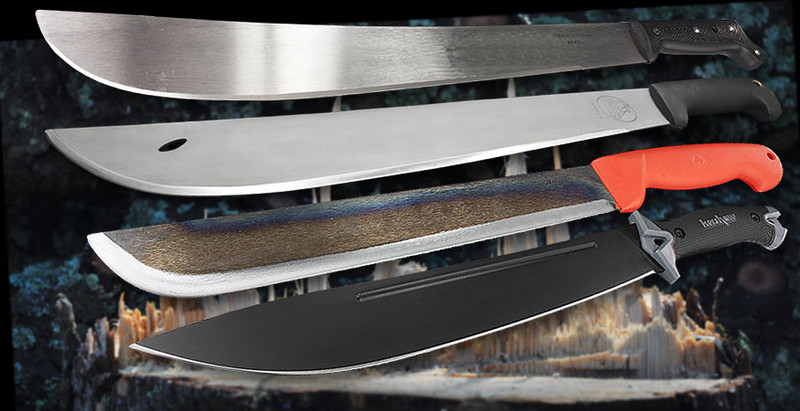
Machetes are versatile tools used for cutting and chopping vegetation. Gardeners, farmers, and outdoor enthusiasts commonly utilize them.
Machetes serve various purposes across different cultures and environments. These long, broad blades make short work of tall grass, thick brush, and woody plants. They’re indispensable in agriculture for tasks like harvesting sugarcane and clearing land for planting. Outdoor adventurers rely on machetes for trail maintenance and campsite management, cutting firewood, and even for self-defense against wild vegetation.
Their durability and efficiency make them a go-to tool in tropical regions where dense foliage is a constant challenge. With origins tracing back to agricultural tools, machetes have evolved into multipurpose implements, essential for both daily tasks and specialized outdoor activities.
The Blade That Shaped History
Machetes have long been a tool and weapon that have played a critical role in history. Their simple yet versatile design has helped shape civilizations, clear paths through dense jungles, harvest crops, and even influence cultural folklore. Steeped in history and wrapped in legend, the machete is more than just a blade. It is a symbol of survival, labor, and identity across various cultures.
Origins And Cultural Significance
The machete’s story begins centuries ago, etched into the very fabric of human civilization. Originally conceptualized for farm work, its purpose quickly expanded. Different cultures adopted the machete, each imparting unique significance and adaptations. It became a farmer’s aid, a warrior’s weapon, and a symbol for freedom movements. The machete’s roots can be traced back to various continents, molding its status as a universal tool.
Here are key highlights of cultural impact:
- Latin America: Integral in sugar cane fields; a symbol of livelihood.
- Caribbean: Used in ceremonial dances and defense.
- Africa: Essential for clearing brush and tribal use.
- Asia: Employed in rice paddies and bamboo cutting.
Evolution Of The Machete Design
Over time, the machete has been given a new edge. Innovations catering to both form and function have seen the blade evolve. The machete now exhibits as many shapes as it has uses. From the Bolo to the Kukri, each variation tells a unique story, empowered by the specifics of its design to meet local needs.
Major design types include:
| Type | Features | Region |
|---|---|---|
| Bolo | Curved blade, heavier tip | Southeast Asia |
| Kukri | Distinctive inward curve | South Asia |
| Panga | Broad blade, curved belly | Africa |
| Parang | Thick blade, S-curve edge | Malay Archipelago |
Each design serves a specific purpose. The Bolo focuses on chopping thick vegetation. The Kukri, with its inward curve, excels at slicing. The Panga and Parang offer versatility and control for detailed tasks. The evolution of the machete goes hand-in-hand with the diversity of human enterprise, showcasing an array of designs as rich as the history they carry.
Anatomy Of A Machete
Anatomy of a Machete: The machete is a powerful tool, widely used across various cultures for numerous tasks. Understanding its anatomy is vital for both efficient use and safety.
Key Components And Materials
The main parts of a machete include the blade, handle, and sometimes a handguard. Materials vary greatly:
- Blades: Typically made from carbon steel or stainless steel for durability.
- Handles: Wood, plastic, or rubber are common, providing a firm grip.
- Handguards: Metal or plastic, they protect the user’s hand.
Varieties Of Blade Shapes And Sizes
Machetes come in several shapes and sizes, each suited to different tasks:
| Blade Type | Use Case |
|---|---|
| Bolo: | Agricultural tasks. |
| Parang: | Cutting thick vegetation. |
| Kukri: | All-purpose; famous for its inward curve. |
Different blade lengths offer varied control and cutting power.
Agricultural Applications
Welcome to the diverse world of machetes – a tool as versatile as it is robust. Farmers and gardeners find these blades indispensable in their daily tasks. They serve a variety of functions in the broad field of agriculture. Here, we delve into the agricultural applications of machetes, concentrating on their essential role in farming activities.
Clearing Brush And Harvesting Crops
Machetes excel in land clearance. They swiftly cut through dense vegetation, clearing paths, and preparing fields for planting. This function is not just about slashing away unwanted greenery; it’s an art requiring precision and skill. Moreover,
- Machetes remove weeds that compete with crops for nutrients.
- They help in harvesting various crops, like sugarcane and rice, with seamless, effective swings.
Each crop has a specific type of machete for optimal efficiency. For instance, a curved blade suits the harvesting of tall stalks.
Land Management And Soil Preparation
Farmers manage their land with machetes to maintain a healthy field. Whether chopping up organic matter to decompose or creating clean planting rows, machetes are fundamental.
Good soil preparation ensures that crops have an excellent growth environment. The use of machetes in preparing the land involves:
- Chopping up old crops and incorporating them into the soil as compost.
- Creating neat, measured beds or rows for seed planting.
These activities enhance soil fertility and structure, ensuring that seeds have the best start in life.

Credit: www.fieldandstream.com
Survival And Outdoor Utility
Machetes serve as versatile tools for those braving the wilderness. When you’re miles away from civilization, a robust machete can mean the difference between survival and distress. With a multitude of uses ranging from trail navigation to resource gathering, it’s a must-have in any adventurer’s pack.
Essential Gear For Wilderness
As you step into the wild, a machete stands out as an essential piece of gear. Its durable blade slashes through dense underbrush, clearing paths or creating signals for rescue. Its weight balance makes it ideal for chopping and hacking in survival scenarios. Keep your machete within easy reach, and you hold a key to outdoors mastery.
Building Shelters And Firewood Gathering
In open country, a machete is indispensable for constructing shelters. Its broad blade is perfect for cutting branches and vines, helping you build a safe haven against the elements. When night falls, collecting firewood is a cinch. With clean strokes, a machete easily processes wood for a roaring fire, essential for warmth and cooking.
Beyond shelter, these tools are also handy for foraging. Wild edibles or medicinal plants can be harvested swiftly with a quick flick of the wrist. Finally, when faced with wildlife, a machete’s intimidating size can be a deterrent or defense, keeping you safe in unforeseen situations.
Machetes In Combat And Self-defense
The machete isn’t just a tool for cutting through the wilderness. It has a history of use in combat and self-defense. This blade, often known for its agricultural benefits, reveals its versatility on the battlefield. Understanding its role requires a look at its past and present use in warfare and self-protective scenarios.
Historical Use In Warfare
The machete has served warriors and soldiers across various cultures. It has proven its worth in combat. The wielder could swing it with speed, cutting down enemies effectively.
- Latin American revolutions: Freedom fighters brandished machetes.
- Philippine martial arts: Trained in the art of Eskrima with machetes.
- African conflicts: Used due to its easy availability.
Modern Perspectives On Machete As A Weapon
Today, the view of the machete as a weapon is complex. It remains a practical defense tool.
| Attribute | Impact on Use |
|---|---|
| Availability | Common and accessible, making it a go-to for many. |
| Legality | Legal in most places, compared to firearms. |
| Training | Simple to use, with no formal training needed. |
Enthusiasts and experts alike practice its use in martial arts. It’s respected for both its offensive and defensive capabilities.
In certain regions, the machete is frequently employed for personal protection. Those seeking a means of self-defense often turn to this blade due to its effectiveness.

Credit: heinnie.com
Maintenance And Safety
Maintaining your machete is vital for both performance and safety. A well-kept blade cuts more efficiently and minimizes the risk of accidents. Follow these guidelines to keep your machete in top condition.
Proper Cleaning Techniques
Keep your machete clean to prevent rust and ensure longevity. Use these steps:
- Wipe the blade with a damp cloth after use.
- Clean off any sap, resin, or plant material.
- Dry the blade completely to avoid rust.
- Apply a light coat of oil to the blade for protection.
Sharpening Your Machete
A sharp machete is safer and more effective. To sharpen:
- Secure the machete in a vise or with a clamp.
- Use a file or whetstone, moving in one direction.
- Follow the existing angle of the blade’s edge.
- Repeat until the desired sharpness is achieved.
Safe Handling Practices
Safe handling is crucial to avoid injury. Remember these tips:
- Always cut away from your body.
- Keep your fingers clear of the blade.
- Use a sturdy and comfortable grip.
- Store in a sheath to protect the blade and user.
Legal And Ethical Considerations
Machetes are versatile tools used in various activities around the world. While their utility is undeniable, it’s essential to understand the legal and ethical considerations surrounding their ownership and use. Different regions have diverse regulations, and responsible usage is paramount, particularly in activities like hunting and conservation.
Regulations Around Ownership
Owning a machete comes with legal responsibilities. Laws vary from place to place, so it’s crucial to know your local guidelines.
For example, some areas require permits or have age restrictions for ownership. Others may classify machetes as agricultural tools rather than weapons. Such distinctions impact how you can carry or transport them.
Non-compliance with local laws can lead to penalties. It is the owner’s duty to stay informed and act within legal frameworks to avoid any legal issues.
Ethical Use In Hunting And Conservation
Ethical use of a machete in hunting and conservation is about respecting wildlife and natural habitats. Hunters use machetes for trail-making or game dressing, while conservationists may use them to manage vegetation.
- Maintain balance in ecosystems by avoiding over-harvesting vegetation.
- Ensure minimal suffering for game during hunting activities.
- Use machetes for habitat restoration and invasive species control.
The principles of fair chase and conservation ethics guide these activities. They stipulate the need for respect towards nature and sustainable practices.
Whether for maintaining trails, clearing brush, or responsibly taking game, machetes should be used with consideration for the environment and local wildlife populations. Adhering to these principles safeguards ecosystems for future generations.

Credit: www.amazon.com
Frequently Asked Questions On What Are Machetes Used For
What Do People Use Machete For?
People use machetes for chopping vegetation, agricultural tasks, cutting wood, and as a tool for outdoor survival.
Why Do People Carry Machetes?
People carry machetes for agricultural purposes, such as cutting through dense vegetation. They also use them for outdoor activities like camping and as tools in various manual labor tasks.
Is A Machete Good For Combat?
A machete can serve as a combat tool, but it’s primarily designed for chopping vegetation, not optimized for battle. There are better-suited weapons for combat situations.
How Effective Is A Machete As A Weapon?
A machete can be an effective weapon due to its sharp blade and versatility in close combat. Its length provides reach and chopping power, making it suitable for self-defense.
Conclusion
As we’ve explored, machetes serve diverse purposes, from agricultural tasks to survival scenarios. These versatile tools chop, clear, and carve with ease. Whether for gardening or adventure, a machete proves essential. Embrace its utility, respect its power, and ensure your outdoor toolkit is complete.
Choose the right machete and master its uses for efficiency and safety alike.




















